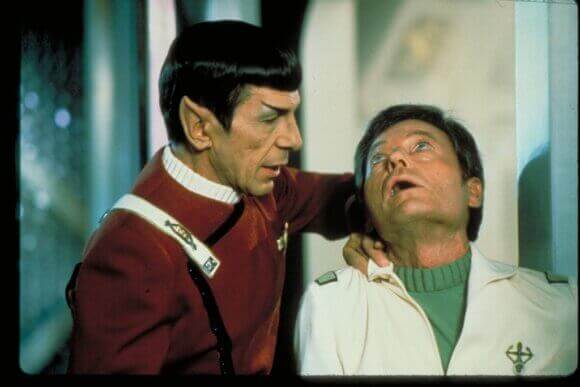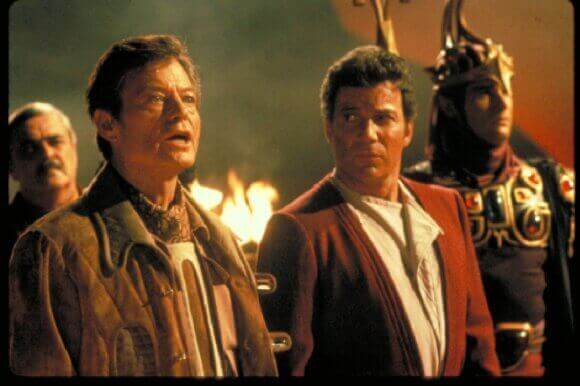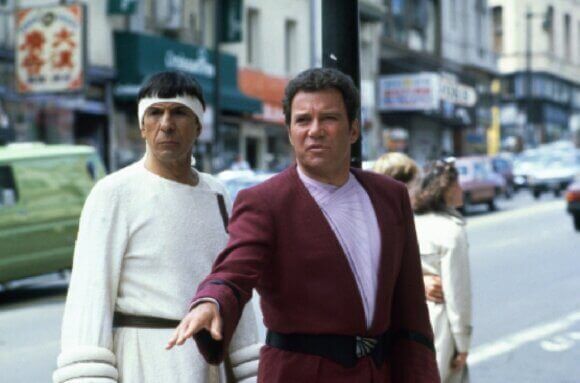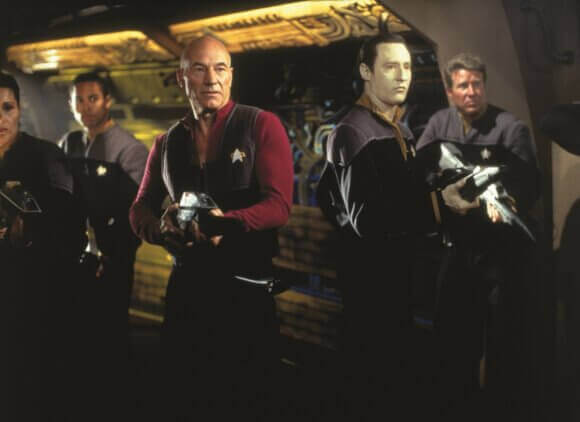

Created by the late Gene Roddenberry, Star Trek has been around in one form or another since the first episode of Star Trek: The Original Series (TOS) debuted on NBC on Sept. 8, 1966.
TOS lasted three seasons and 79 episodes. However, it found a new life in syndication. With the success of 1977’s Star Wars and 1977’s Close Encounters of the Third Kind (during the nascent days of the summer blockbuster), long-time Trekkies were hoping to see their beloved characters on the big screen, which they did in 1979’s Star Trek: The Motion Picture.
Today, Trek is a pop culture juggernaut. It has to its name 13 feature films, eight TV series, three animated series, and numerous novels, comics, action figures, and other merchandise. Pretty impressive. Not to mention pretty intimidating if you want to go where no one has gone before for the first time.
The following five movies serve as an entryway into Trek for the uninitiated.
1). Star Trek II: The Wrath of Khan (1982): While Star Trek: The Motion Picture made a respectable $139 million at the box office, it received mixed reviews and was criticized for lack of action scenes, slow pacing, and for being too long. The 23rd-century uniforms inspired by 1970s fashions also didn’t do it any favors in subsequent rewatches. But it did bring back the original cast on the big screen and made enough bank to warrant a sequel, which moved ahead without Roddenberry’s input.
For many Trekkies, this is where the movie adventures of the original crew truly begin. Admiral James T. Kirk (William Shatner) battles an old enemy, the genetic superman Khan Noonien Singh (Ricardo Montalbán, reprising his role from “Space Seed,” the 1967 TOS episode). Khan hijacks the U.S.S. Reliant and goes after the U.S.S. Enterprise, which is under Kirk’s command. Khan will spare Kirk’s crew if he turns over information on the Genesis Device, which can reanimate dead matter. During a pitched battle, the Enterprise is badly damaged and Khan activates the Genesis Device in an attempt to wipe out Kirk and company.
Man of action that he is, Kirk manages to turn the tables on Khan, who dies in the end, but the axiom, “there’s no such thing as victory without a cost,” applies here. SPOILER: Spock (Leonard Nimoy) dies, sacrificing his life in order to save the Enterprise. After a touching eulogy from Kirk, Spock’s casket is torpedoed onto the newly created planet vis-à-vis the Genesis Device.
Khan was a box office success with positive reviews from fans and critics alike. You don’t have to be a Trekkie to understand the history of Kirk and Khan; this battle stands on its own. Director Nicholas Meyer delivered a sequel that is much better than the original. The film’s pacing is light years ahead of the previous one, the costuming much better (the uniforms that debuted here were used throughout the rest of the movies with the original cast), and the performances excellent (particularly Montalbán’s).
While the special effects seem dated, that’s a small complaint; the performances and the script more than compensate. Khan, which is the first of what can be unofficially called the “Spock trilogy,” is one of the best films in the franchise – many argue that it’s the best – and is often credited with breathing new life into Trek.

2). Star Trek III: The Search for Spock (1984): There was a saying that the odd-numbered films featuring the original cast are bad and the even-numbered ones are good. Spock – the second part of the “Spock trilogy” – is the exception. The Enterprise returns to Earth after battling Khan. There, Admiral Morrow (Robert Hooks) tells Kirk his beloved ship will be decommissioned and orders his crew not to speak about Genesis.
David Marcus (Merritt Butrick), Kirk’s son introduced in Khan, and Lt. Saavik (Robin Curtis) explore the Genesis Planet and discover it has returned Spock to life as a baby who rapidly ages, although his mind isn’t present within his body. Before he died in Khan, Spock mind-melded with Dr. Leonard “Bones” McCoy (DeForest Kelley), transferring his katra (life-essence) to the crusty physician. Kirk realizes there may be a chance to save Spock, but the Starfleet brass shuts him down.
Defying orders, Kirk and the crew hijack the Enterprise to go save Spock. Along the way, they battle Klingons (the leader played by Back to the Future’s Christopher Lloyd and another by Night Court’s John Larroquette) and have no choice but to blow up the Enterprise. Although they save Spock, David is killed. Shatner, who has been criticized for hamming it up and overacting throughout his 60-year career, does none of that here when Kirk learns of David’s death. Kirk’s grief is genuine, and you can’t help but feel sorry for him.
In the end, they make it to Vulcan on a hijacked Klingon starship, where Spock’s mind and body are reunited. Rescuing Spock cost Kirk his ship and son, but if he didn’t try, it would’ve cost him his soul. Slightly confused at first, Spock (now played by Nimoy, who directed this film) speaks to Kirk, then the rest of his shipmates gather around him, demonstrating their bonds of friendship and loyalty go far beyond following orders.

3). Star Trek IV: The Voyage Home (1986): The conclusion of the “Spock trilogy,” directed by Nimoy, has the Enterprise crew returning to Earth to stand trial for treason after disobeying orders in Spock.
En route, a mysterious space probe travels to Earth, creating worldwide destruction in many forms. A signal is sent out for every ship to avoid Earth. After analyzing the sounds emitted by the probe, Spock concludes they match those of humpback whales, now extinct. Kirk and company go back in time to gather a whale to answer the probe.
What follows is a “fish out of water” comedy as the Enterprise crew navigates San Francisco (future home of Starfleet Command) in 1986, a “primitive and paranoid culture” that uses plenty of “colorful metaphors” (i.e., expletives). Some funny scenes involve Spock swearing and everyone trying to acclimate to 20th-century customs and social norms. Great stuff.
In the end, Kirk and crew bring two humpback whales named George and Gracie and Dr. Gillian Taylor (Catherine Hicks) back to their time. The whales communicate with the probe, which leaves Earth peacefully and all the global catastrophes suddenly cease. The Earth safe once again, the charges against the Enterprise crew are dropped with the exception of one directed only at Kirk. He is busted down in rank from admiral to captain – something he always wanted – and reunites with his crew on the newly-christened Enterprise-A at the movie’s conclusion. “My friends, we’ve come home,” says Kirk. Indeed they have.
Being in what was then modern times made Trek accessible to a mainstream audience, as its $133 million box office gross against a $26 million budget clearly illustrates. Upbeat with a happy ending, a message about saving the whales, Voyage Home is the most lighthearted of all the Trek movies – and one of the most enjoyable.

4). Star Trek: First Contact (1996): Easily the best movie to feature the Star Trek: The Next Generation (TNG) cast. First Contact brings the Borg to the big screen. The movie opens with Capt. Jean-Luc Picard (Patrick Stewart) having a nightmare about being assimilated by the Borg into Locutus in “The Best of Both Worlds,” the 1990 TNG 2-parter largely considered its best episode.
Picard is ordered to stay away from the Borg as it decimates the fleet on its way to Earth. Disobeying orders, Picard assumes command of the fleet. The Borg travels back in time to April 4, 2063 in order to prevent Zefram Cochrane’s (Oscar nominee James Cromwell) historic warp drive flight that leads to humanity’s first contact with extraterrestrial life (in this case, Vulcans).
There is a feeling of claustrophobic scariness that you feel from 1986’s Aliens as Picard and crew battle the Borg in the corridors of the Enterprise-E. The tension ramps up with every scene, especially as the Borg kidnaps Lt. Cmdr. Data (Brent Spiner).
First Contact has plenty of firsts: It’s Jonathan Frakes’ (aka Cmdr. William Riker) feature film directorial debut (and it is spectacular!), the debut of the Borg Queen (Alice Krige), and the debut of the Enterprise-E. Oscar winner Alfre Woodard, making her Trek debut, has a strong supporting role as Lily Sloane. Neal McDonough – who would go on to Desperate Housewives and the Marvel Cinematic Universe – has a bit part as a redshirt named Lt. Hawk.
Stewart gives a tour-de-force performance as Picard, portraying him with a heretofore unseen ferocity. The normally emotionally reserved, pragmatic captain is so bent on destroying the Borg that it becomes an obsession, drawing comparison to Capt. Ahab chasing the white whale in Moby-Dick. Unlike Ahab, Picard listens to reason and manages to thwart the Borg, save history from being altered, and return to the present (similar to the Voyage Home in some ways).
Like Khan, you don’t have to understand Picard’s history with the Borg to enjoy this movie. The introduction of the Borg Queen – who has this aura of mystique, danger, and sex appeal – takes care of that and lets you enjoy a riveting action movie. While one of the darkest entries in the Trek films – if not the darkest – it’s also one of the greatest.

5). Star Trek (2009): After the commercial and critical failure of 2002’s Star Trek: Nemesis (the last TNG movie) and the cancellation of Star Trek: Enterprise in 2003, Trek was lethargic and suffering from “franchise fatigue.” Behind the scenes, Viacom and CBS separated.
In 2009, Mission: Impossible III director J.J. Abrams – who co-created Alias, Felicity, and Lost – directed a franchise reboot simply titled Star Trek to make it accessible to non-Trekkies. Abrams takes characters from TOS and recasts them with new actors. Kirk is now played by Chris Pine, Spock is now played by Zachary Quinto, Bones is now played by Karl Urban, et al. Nimoy appears as the original Spock (or Spock Prime, per the credits).
After the destruction of Romulus, Nero (Eric Bana) travels back in time and destroys the U.S.S. Kelvin, resulting in the death of Capt. George Kirk (a pre-Thor Chris Hemsworth), thus creating an alternate reality. Abrams did this to free the movie and the franchise itself from what was then nearly 40 years of established continuity without compromising it. At the same time, it could go in new directions.
To get revenge on Spock Prime, who failed to prevent Romulus’ destruction and whom Nero blames for the death of his family, Nero destroys Vulcan. Kirk eventually assumes command of the Enterprise and becomes captain, achieving his best destiny.
Star Trek grossed about $386 million at the box office, spawning 2013’s Star Trek: Into Darkness and 2016’s Star Trek: Beyond, both of which features this cast. The success of this reboot paved the way for the five new series (two of which are animated) on the streaming service Paramount+, most notably Star Trek: Picard. Love him or hate him, Abrams gave Trek a much-needed shot in the arm and made it more accessible to mainstream audiences, not just Trekkies.
HONORABLE MENTION: Star Trek VI: The Undiscovered Country (1991): Skip 1989’s forgettable Star Trek V: The Final Frontier and watch this movie, which gives the original cast – together again for the final time – the send-off it didn’t get when TOS was abruptly cancelled in 1969. Meyer, who co-wrote the screenplay, also returns to the director’s chair for the last hurrah.
The destruction of the Klingon moon Praxis leads the once-mighty Klingon Empire to sue for peace with its long-time enemy, the United Federation of Planets. Initially, Kirk is against the peace talks, vocal in his hatred for Klingons after they murdered his son in Spock. There are factions in both the Klingon Empire and the Federation who also don’t want peace and will do anything to keep things status quo, including framing Kirk and McCoy for the murder of the Klingon chancellor Gorkon (David Warner). Spock and the Enterprise crew rush to their rescue and learn of the conspiracy.
It should be noted Sulu (George Takei) has finally become a captain (he’s in command of the U.S.S. Excelsior) and finally given a first name: Hikaru. Oscar winner Christopher Plummer portrays General Chang of the Klingon Empire, Kirk’s new nemesis; Iman portrays a shape-shifting alien named Martia; there are also cameos from Christian Slater and Michael Dorn. Dorn plays Col. Worf, the grandfather of his character Worf on TNG.
After the heroes “save civilization as we know it,” they are ordered to return the Enterprise to base to be decommissioned. Once again, Kirk disobeys orders and flies the Enterprise to the “second star to the right and straight on ‘til morning.” His final captain’s log is a touching entry as he mentions the Enterprise will soon become the property of a new crew who will continue going where no one has gone before. A classy ending, the original crew really goes out in style.
The post Jumping on Point: ‘Star Trek’ – Top 5 Essential ‘Star Trek’ Films appeared first on ShowbizJunkies.


0 Comments